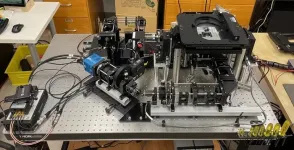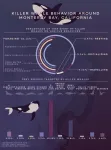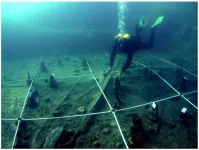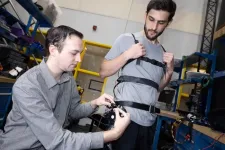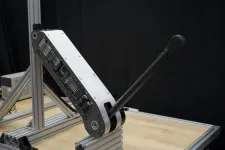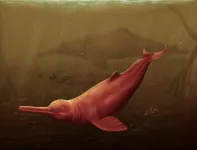(Press-News.org) The first generation of stars transformed the universe. Inside their cores, simple hydrogen and helium fused into a rainbow of elements. When these stars died, they exploded and sent these new elements across the universe. The iron running in your veins and the calcium in your teeth and the sodium powering your thoughts were all born in the heart of a long-dead star.
No one has been able to find one of those first generation of stars, but scientists have announced a unique finding: a star from the second generation that originally formed in a different galaxy from ours.
“This star provides a unique window into the very early element-forming process in galaxies other than our own,” said Anirudh Chiti, a University of Chicago postdoctoral fellow and first author on a paper announcing the findings. “We have built up an idea of the how these stars that were chemically enriched by the first stars look like in the Milky Way, but we don’t yet know if some of these signatures are unique, or if things happened similarly across other galaxies.”
The paper was published March 20 in Nature Astronomy.
‘Fishing needles out of haystacks’
Chiti specializes in what is called stellar archaeology: Reconstructing how the earliest generations of stars changed the universe. “We want to understand what the properties of those first stars were and what were the elements they produced,” said Chiti.
But no one has yet managed to directly see these first-generation stars, if any remain in the universe. Instead, Chiti and his colleagues look for stars that formed from the ashes of that first generation.
It’s hard work, because even the second generation of stars is now incredibly ancient and rare. Most stars in the universe, including our own sun, are the result of tens to thousands of generations, building up more and more heavy elements each time. “Maybe fewer than 1 in 100,000 stars in the Milky Way is one of these second-gen stars,” he said. “You really are fishing needles out of haystacks.”
But it’s worth it to get snapshots of what the universe looked like back in time. “In their outer layers, these stars preserve the elements near where they formed,” he explained. “If you can find a very old star and get its chemical composition, you can understand what the chemical composition of the universe was like where that star formed, billions of years ago.”
An intriguing oddity
For this study, Chiti and his colleagues aimed their telescopes at an unusual target: the stars that make up the Large Magellanic Cloud.
The Large Magellanic Cloud is a bright swath of stars visible to the naked eye in the Southern Hemisphere. We now think it was once a separate galaxy that was captured by the Milky Way’s gravity just a few billion years ago. This makes it particularly interesting because its oldest stars were formed outside the Milky Way—giving astronomers a chance to learn about whether conditions in the early universe all looked the same, or were different in other places.
The scientists searched for evidence of these particularly ancient stars in the Large Magellanic Cloud and catalogued ten of them, first with the European Space Agency’s Gaia satellite and then with the Magellan Telescope in Chile.
One of these stars immediately jumped out as an oddity. It had much, much less of the heavier elements in it than any other star yet seen in the Large Magellanic Cloud. This means it was probably formed in the wake of the first generation of stars—so it had not yet built up heavier elements over the course of repeated star births and deaths.
Mapping out its elements, the scientists were surprised to see that it had a lot less carbon than iron compared to what we see in Milky Way stars.
“That was very intriguing, and it suggests that perhaps carbon enhancement of the earliest generation, as we see in the Milky Way, was not universal,” Chiti said. “We’ll have to do further studies, but it suggests there are differences from place to place.
“I think we’re filling out the picture of what the early element enrichment process looked like in different environments,” he said.
Their findings also corroborated other studies that have suggested that the Large Magellanic Cloud made much fewer stars early on compared to the Milky Way.
Chiti is currently leading an imaging program to map out a large portion of the southern sky to find the earliest stars possible. “This discovery suggests there should be many of these stars in the Large Magellanic Cloud if we look closely,” he said. “It’s really exciting to be opening up stellar archeology of the Large Magellanic Cloud, and to be able to map out in such detail how the first stars chemically enriched the universe in different regions.”
END
Scientists find one of the most ancient stars that formed in another galaxy
Stars from the Large Magellanic Cloud reveal new hints about how the universe got its elements
2024-03-20
ELSE PRESS RELEASES FROM THIS DATE:
Researchers add swept illumination to open-top light-sheet microscope
2024-03-20
Researchers have incorporated a swept illumination source into an open-top light-sheet microscope to enable improved optical sectioning over a larger area of view. The advance makes the technique more practical for nondestructive 3D pathology.
3D pathology is being explored as an alternative to traditional slide-based histology because it can provide detailed 3D insights into pathological structures and cellular interactions without altering the tissue. This approach makes it possible to analyze complex 3D tissue structures and to image thick tissues, which is not possible with slide-based methods.
The researchers used their improved open-top ...
High-quality microwave signals generated from tiny photonic chip
2024-03-20
In a new Nature study, Columbia Engineering researchers have built a photonic chip that is able to produce high-quality, ultra-low-noise microwave signals using only a single laser. The compact device — a chip so small, it could fit on a sharp pencil point — results in the lowest microwave noise ever observed in an integrated photonics platform.
The achievement provides a promising pathway towards small-footprint ultra-low-noise microwave generation for applications such as high-speed communication, atomic clocks, and autonomous vehicles.
The challenge
Electronic devices for global navigation, wireless communications, radar, and ...
OFC 2024 brings innovations from leading global organizations and cutting-edge tech demonstrations to California
2024-03-20
SAN DIEGO—A wave of innovation is hitting California as the Optical Fiber Communications Conference and Exhibition (OFC) gears up to showcase the latest breakthroughs in optical communications and networking.
OFC will take place at the San Diego Convention Center from 24 to 28 March 2024 drawing industry leaders, experts, academia, media, analysts and students from around the world to explore the latest in optical technology.
Innovative advancements in industrial technologies, as well as research in 800ZR, Coherent PON, Linear Pluggable Optics (LPO), multicore fiber, AI and ...
Killer whales use specialized hunting techniques to catch marine mammals in the open ocean
2024-03-20
Killer whales foraging in deep submarine canyons off the coast of California represent a distinct subpopulation that uses specialized hunting techniques to catch marine mammals, Josh McInnes at the University of British Columbia and colleagues report March 20 in the open-access journal PLOS ONE.
Killer whales (Orcinus orca) are found in oceans around the world, but they form separate populations, or ‘ecotypes’, that have their own social structure, food preferences and hunting behaviors. One ecotype, known as transient killer whales, specialize in hunting marine ...
The first Neolithic boats in the Mediterranean
2024-03-20
More than 7,000 years ago, people navigated the Mediterranean Sea using technologically sophisticated boats, according to a study published March 20, 2024 in the open-access journal PLOS ONE by Juan F. Gibaja of the Spanish National Research Council, Barcelona and colleagues.
Many of the most important civilizations in Europe originated on the shores of the Mediterranean Sea. During the Neolithic, communities clearly traveled and traded across the water, as evidenced by watercraft in the archeological record and the presence ...
Universal controller could push robotic prostheses, exoskeletons into real-world use
2024-03-20
Robotic exoskeletons designed to help humans with walking or physically demanding work have been the stuff of sci-fi lore for decades. Remember Ellen Ripley in that Power Loader in Alien? Or the crazy mobile platform George McFly wore in 2015 in Back to the Future, Part II because he threw his back out?
Researchers are working on real-life robotic assistance that could protect workers from painful injuries and help stroke patients regain their mobility. So far, they have required extensive calibration and context-specific tuning, which keeps them largely limited to research labs.
Mechanical engineers at Georgia Tech ...
Autism acceptance varies across countries – where should we target support?
2024-03-20
Societal acceptance of autism varies considerably across different countries, with lowest levels of acceptance found in Japan and Belgium, new research shows.
A survey of 306 autistic individuals from eight countries revealed that around three quarters of respondents do not feel accepted, or only sometimes feel accepted, as an autistic person. Among these countries, participants in Japan and Belgium reported the lowest levels of acceptance, while those in Canada, the UK, and South Africa reported comparatively higher levels.
The study, published in PLOS ONE, is the ...
A replacement for traditional motors could enhance next-gen robots
2024-03-20
Whether it’s a powered prosthesis to assist a person who has lost a limb or an independent robot navigating the outside world, we are asking machines to perform increasingly complex, dynamic tasks. But the standard electric motor was designed for steady, ongoing activities like running a compressor or spinning a conveyor belt – even updated designs waste a lot of energy when making more complicated movements.
Researchers at Stanford University have invented a way to augment electric motors to make them much more efficient at performing dynamic ...
Icy impacts: Planetary scientists use physics and images of impact craters to gauge the thickness of ice on Europa
2024-03-20
WEST LAFAYETTE, Ind. — Sometimes planetary physics is like being in a snowball fight. Most people, if handed an already-formed snowball, can use their experience and the feel of the ball to guess what kind of snow it is comprised of: packable and fluffy, or wet and icy.
Using nearly the same principles, planetary scientists have been able to study the structure of Europa, Jupiter’s icy moon.
Additional Information
When worlds collide: Studying impact craters to uncover the secrets of the solar system
Breaking in a new planet
Purdue scientists and engineers push the boundaries of space knowledge, studying the ...
Ancient giant dolphin discovered in the Amazon
2024-03-20
Measuring between 3 to 3.5 meters, 16 million years old: Paleontologists from the University of Zurich have announced the discovery of a new species of freshwater dolphin in the Peruvian Amazon region. Surprisingly, its closest living relatives can be found in the river dolphins of South Asia.
River dolphins are among the rarest modern cetaceans, with most extant species critically endangered. Despite their similar appearance, however, these animals are not directly related, but represent the late survivors of different cetacean groups that once inhabited our planet.
An international ...
LAST 30 PRESS RELEASES:
Heart-brain connection: international study reveals the role of the vagus nerve in keeping the heart young
Researchers identify Rb1 as a predictive biomarker for a new therapeutic strategy in some breast cancers
Survey reveals ethical gaps slowing AI adoption in pediatric surgery
Stimulant ADHD medications work differently than thought
AI overestimates how smart people are, according to HSE economists
HSE researchers create genome-wide map of quadruplexes
Scientists boost cell "powerhouses" to burn more calories
Automatic label checking: The missing step in making reliable medical AI
Low daily alcohol intake linked to 50% heightened mouth cancer risk in India
American Meteorological Society announces Rick Spinrad as 2026 President-Elect
Biomass-based carbon capture spotlighted in newly released global climate webinar recording
Illuminating invisible nano pollutants: advanced bioimaging tracks the full journey of emerging nanoscale contaminants in living systems
How does age affect recovery from spinal cord injury?
Novel AI tool offers prognosis for patients with head and neck cancer
Fathers’ microplastic exposure tied to their children’s metabolic problems
Research validates laboratory model for studying high-grade serous ovarian cancer
SIR 2026 delivers transformative breakthroughs in minimally invasive medicine to improve patient care
Stem Cell Reports most downloaded papers of 2025 highlight the breadth and impact of stem cell research
Oxford-led study estimates NHS spends around 3% of its primary and secondary care budget on the health impacts of heat and cold in England
A researcher’s long quest leads to a smart composite breakthrough
Urban wild bees act as “microbial sensors” of city health.
New study finds where you live affects recovery after a hip fracture
Forecasting the impact of fully automated vehicle adoption on US road traffic injuries
Alcohol-related hospitalizations from 2016 to 2022
Semaglutide and hospitalizations in patients with obesity and established cardiovascular disease
Researchers ‘listen in’ to embryo-mother interactions during implantation using a culture system replicating the womb lining
How changing your diet could help save the world
How to make AI truly scalable and reliable for real-time traffic assignment?
Beyond fragmented markets: A new framework for efficient and stable ride-pooling
Can shape priors make road perception more reliable for autonomous driving?
[Press-News.org] Scientists find one of the most ancient stars that formed in another galaxyStars from the Large Magellanic Cloud reveal new hints about how the universe got its elements
